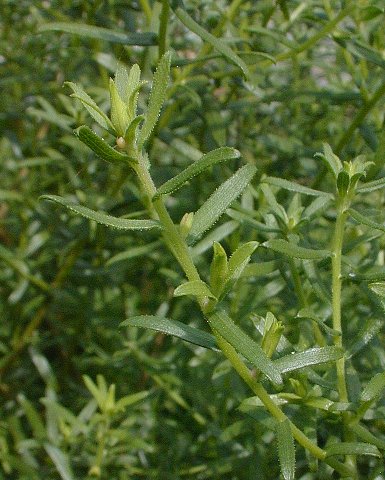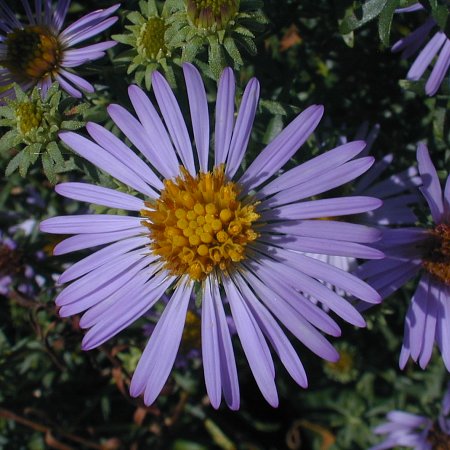Description: This perennial plant is 1-2' tall, branching frequently to create a bushy appearance. The slender stems are rather stiff and slightly pubescent; the lower stems turn brown and become slightly woody during the fall. The alternate leaves are up to 2" long and ½" across, becoming smaller as they ascend the stems; they are typically one-half the maximum size or a little less. They are linear to linear-oblong, slightly pubescent, and smooth along the slightly ciliate margins. These leaves are rather densely crowded along the stems (particularly the upper stems) and sessile.

The compound
flowers are daisy-like and about 1–1¼" across. Each compound flower
consists of about 20-35 blue-violet or purple ray florets that surround
numerous disk florets that are yellow or amber. These disk florets
later become reddish purple. Each compound flower is subtended by
spreading linear bracts that resemble the upper leaves. The blooming
period occurs during the fall and lasts about 1-2 months; a robust
plant will be covered with flowerheads. There is no noticeable floral
scent, although the crushed foliage and flowerheads have a balsam-like
aroma. Aromatic Aster is one of the last wildflowers to bloom prior to
heavy frost. The achenes have small tufts of light brown hair and are
distributed by the wind. The root system is fibrous and rhizomatous;
older plants often have a short caudex. There can be significant
variability in the characteristics of plants across different locations.
Cultivation:
The preference is full sun and dry conditions, although an average
moisture level is tolerated if the site is well-drained. Poor, rocky
soil with open terrain is preferred; a high pH is tolerated. Some of
the lower leaves may wither away before the plants begin to bloom, but
the foliage usually remains quite attractive. At moist fertile sites,
this plant has trouble competing against tall aggressive plants, unless
such neighbors are selectively weeded out.

Range &
Habitat:
The native Aromatic Aster occurs primarily in northern Illinois, the
hilly sections of southern Illinois, and in areas bordering the
Mississippi and Illinois rivers (see Distribution
Map). It is generally an uncommon plant, although locally
common at a few exceptional sites. Habitats include mesic to dry gravel
prairies, dolomite prairies, gravelly hill prairies, limestone glades,
and rocky bluffs along major rivers.
Faunal Associations:
Many insects visit the flowers, including long-tongued bees,
short-tongued bees, small to medium-sized butterflies, and skippers.
These insects seek nectar primarily, although the bees also collect
pollen. Many kinds of insects feed on the foliage and other parts of
asters, including the caterpillars of the butterfly Chlosyne
nycteis (Silvery Checkerspot) and the larvae of many moth species (see Moth Table).
The Wild Turkey and possibly other upland gamebirds eat the seeds and
foliage to a limited extent. Mammalian herbivores occasionally eat the
foliage of asters, even though their food value is low.

Photographic
Location:
The above photographs were taken in the wildflower garden of the
webmaster in Urbana, Illinois.
Comments:
This aster has attractive flowers and is fairly easy to cultivate in a
sunny rock garden and similar areas. Aromatic Aster can be
distinguished from other asters (Symphyotrichum
spp.) by the number of ray florets per flowerhead (greater
than 20), the size of its flowerheads (usually about 1" across or
slightly more), and the spreading linear bracts underneath each
flowerhead. The leaves are shorter and more narrow than those of many
other Aster spp., and they release a pleasant aroma when crushed. In
general habit, Aromatic Aster has denser foliage and a bushier habit
than other asters, which are usually more tall and lanky. In
mass-market horticulture, some plants that are labeled 'Aromatic Aster'
appear to be hybrids of Aromatic Aster and Symphyotrichum
novae-angliae (New England Aster). These cultivated plants
tend to be larger in size and have larger lower leaves; their
flowerheads are slightly larger and more double than those of Aromatic
Aster.